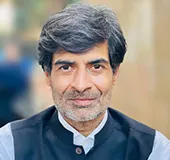PROLOGUE: In April of 2016, UC Berkeley cancelled Milo Yiannopoulos’ planned speech in response to campus protests. For an institution that prides itself on its long and stellar liberal legacy — the centerpiece of which is the freedom to hold and express a view, irrespective of its political persuasion — the Rubicon was silently crossed.
The appeal of liberalism lies in its capacity to accommodate difference, to resist the instinctive urge to reduce the ‘other’ to fit the prisms of the ‘self’, and to recognise their independent and distinct agency. This lends it the unique capacity to account for the ambivalent nature of truth, to recognise and accept the many greys of reality and allow for the creation of assimilative and syncretic spaces.
Liberal, pluralist approaches have formed the basis for modern societies, where diverse opinions, preferences and choices make up a grand social and political canvas.
Ideologies, however, possess a fundamental contradiction: they are seldom ever practised as idealised. Participation in the liberal public sphere was compromised by the inability to widen access and agency beyond a select few with economic means and social ‘status’. The poor, racial and ethnic minorities and even women remained excluded from its ambit.
Key conversations that organised politics, economics and social norms thus largely remained an elite discussion, which despite their apparent differences, shared common class interests and presumptions around morality. This convergence of interests shaped the public discourse. It trickled down to the society through one-way, mass-oriented technologies of print and broadcast media, owned and controlled by this class, informed by their thinking and influenced by their sensibilities. The discourse thus remained incestuous and public consensus often imaginary and contrived.
The inherent flaw in this model was its contrariness to the liberal dictum. It left out large swathes of people who were constrained by the economics of access and politics of acceptance. The liberal public sphere has thus always remained contested and illiberal in its practice.
The domination of a Western cultural-technological narrative, mostly at the cost of indigenous ethos in non-Western settings, meant that it soon became an ideal that was either imposed upon or embraced by societies with sometimes-different social evolutions. This then became another reason of discord in many localities, where existing socio-economic exclusions were reinforced through elite discourse. The marginalised were now also voiceless.
Then came the Internet and social media, which dramatically altered the social canvas. It mainstreamed the marginal.
The ever-reducing cost of the internet sees more users getting online each day, increasing the reach of the medium and the consequent amplification of multiple messages. The ease and simplicity of engagement afforded by social media’s two-way communication architecture has proven the most disruptive.
Breaking from the past, where power simply came to be concentrated with a new elite, and subjugating those not fortunate enough to be a part of it, the new order has dispersed discursive power.
Without the shackles of previous structures, the internet has allowed large sections of society, hitherto outside the public sphere, to organise themselves, script their own narratives and shape their own democracy. The significant lowering of the barriers of entry, allowed, for the first time, meaningful mass participation in public discourse. Attempts to control and regulate access have had limited impact at best, as the medium forever brings forth new methods to circumvent control, and new pathways to agitate, constantly altering ways to propagate and receive ideas.
While the dominant and the marginal have constantly renegotiated their power equations throughout history, what distinguishes the new dynamic is its participative nature. It has levelled class differences. That too at an unprecedented pace. Breaking from the past, where power simply came to be concentrated with a new elite, and subjugating those not fortunate enough to be a part of it, the new order has dispersed discursive power.
The newcomers with digital ‘megaphones’ are not bound by old class structures. Instead, deeply aggrieved by their long exclusion, they have set about recasting the public sphere by challenging class presumptions and breaching the boundaries that define it. For their anger is deeper, their hate more potent, and their victimhood more tragic.
 Source: Pete/CC BY-SA 2.0
Source: Pete/CC BY-SA 2.0
Their revenge and redemption lies in dismantling old structures and antiquated arenas that set the rules of social behaviour and public debate. They have successfully challenged, and in several cases, even usurped established political systems, catapulting into power the marginal, whose project now is to legitimise their world-view and consolidate their new-found power and authority. They sought to recast institutions of state and society in the mould of their truths and beliefs. In many instances, these truths and beliefs were defined not by substantive new ethics but being in contest with the normative.
The new wave was responsible for several populist mass movements in the last decade. The Tunisian Revolution, Arab Spring or the 2011 pro-democracy protests in China constitute resistance at the bleeding edge of this change. On the other hand, the coming to power of populist governments on a fierce anti-establishment plank in the US, India, Indonesia, the Philippines and elsewhere through a process of democratic transition constitutes resistance at the soft edge. Nevertheless, at their core, they share similar objectives and use similar approaches, which combine aggressive street dissent and internet activism. Arising from their disillusionment, the objective of the new stakeholders has mostly gravitated to dismantle what existed while seldom possessing a meaningful alternate blueprint.
The newcomers with digital ‘megaphones’ are not bound by old class structures. Instead, deeply aggrieved by their long exclusion, they have set about recasting the public sphereby challenging class presumptions and breaching the boundaries that define it.
In How the Mind Works, Steven Pinker says that binary logic helps one to quickly choose: between fight or flight, between one moral position and another. This lends it a near hypnotic capacity in public discourses where attention s are notoriously short and competitive appeal relies more on rhetoric than meaning. Diminished in influence and capacity to influence political change, the old elite’s response has situated itself in exploiting this pernicious blindside of mass psyche.
They have sought to oversimplify the discourse by obfuscating inherent subtleties and ambiguities that inform reality, reducing the conversation to binary labels built around reciprocal determination: ‘fake news’; our liberalism versus their illiberalism; our accommodativeness versus their intolerance, our goodness versus their evil. This simplistic binary logic is easier to perpetuate as it does not ensnare the ‘plebs’ in complex subtleties.
Their project relies on reducing newcomers through selective representations made up of half-truths, lumpenising, and denial of agency, in a colonial intellectualism redux. In the manifest, their new narrative is built upon the twin pillars of condescension and fear.
They seek to entangle the newcomers in discussions alien to them, using a mix of provocation and patronage. Their anxiety and uncertain response in new settings is used to contrast this seemingly inferior agency with superior experiences of the ‘self’. The ‘different’ approach of the ‘other’ then becomes the rationale of the politics of disdain, of their boorishness, and lesser agency.
This is captured by the new energy infused into and fear perpetuated through the ‘fake news’ narrative. Framed as a novelty, the liberal elites accuse the newcomers of resorting to it, thereby diminishing the quality of debate and political response. This approach is reductive as it dismisses the real and perceived grievances attached to these narratives. Belittling them as ‘fake’ provides the perfect alibi to ignore accumulated hurt and anger.
And then the hypocrisy. Is ‘fake news’ new? Can we discount its historical role in political and public discourse, and its use by elites who hitherto dominated the public sphere, in furthering their interests and sustaining class dominance? From that standpoint, it at best constitutes a borrowed institutional practice by the new stakeholders.
William Hazlitt once said: ‘Just as much as we see in others we have in ourselves.’ In resorting to labels and framing their discourse through a narrow binary logic, in resorting to the politics of fear and denial of the other’s ‘otherness’, the old elite reveal their Janus face. In seeking to create a counter narrative which is morally absolutist, where the only just choice on offer is theirs, they have become the same as the abhorred other of their imagination — fundamentalist, polarising and dangerous, and every bit as regressive and illiberal.
This clash between the old and the new is for the crown jewels of acquisition, ownership and retention of public influence and space. The ethic at the core of this struggle is power.
Liberal fundamentalism is now at war with unbridled street anger, whose revisionist purpose and impatience have exhibited a dangerous capacity to self-destruct.
Away from this contest for the zeitpolitik, then, participants in the new public sphere, old and new alike, need to arrive at an entente cordiale built upon the vast grounds they share. The only fair redemption is in moving away from binaries, to adopting a syncretic approach that is above the politics of difference; in charting new pathways that are inclusive and representative of mainstream and marginal interests. Such space exists, but between arrogance of the ‘self’ and anger for the ‘other’.
EPILOGUE: In August of 2016, armed French policemen walked up to a woman at a beach in Nice. The woman, in a burkini, was made to remove some of her clothes and ticketed for failing to upkeep ‘secularism and good morals’.
This commentary originally appeared in Open Magazine.
The views expressed above belong to the author(s). ORF research and analyses now available on Telegram! Click here to access our curated content — blogs, longforms and interviews.




 Source:
Source:  PREV
PREV



